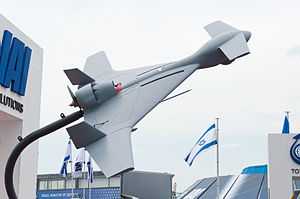IAI Harop
| Harop | |
|---|---|
 | |
| IAI Harop at Paris Air Show 2013 | |
| Role | Attack UCAV |
| National origin | Israel |
| Manufacturer | IAI |
| Developed from | IAI Harpy |
The IAI Harop (or IAI Harpy 2) is an unmanned combat air vehicle (UCAV) developed by the MBT division of Israel Aerospace Industries. Rather than holding a separate high-explosive warhead, the drone itself is the main munition. This SEAD-optimised UCAV is designed to loiter the battlefield and attack targets by self-destructing into them.[1]
Overview
The IAI Harop is a larger version of the IAI Harpy and is launched from ground- or sea-based canisters, but can be adapted for air-launch.[1] Unlike the fully autonomous Harpy, however, the Harop is controlled in flight by a remote operator.[2] The Harop features two guidance modes: it can either home in on radio emissions by itself with its anti-radar homing system,[3] or the operator can select static or moving targets detected by the aircraft's electro-optical sensor.[1] This latter mode allows the Harop to attack radars that are presently shut down and therefore not providing emissions for the aircraft to automatically home in on.[3]
IAI is developing a smaller version of the Harop for smaller applications, which it will unveil in 2015. The smaller Harop would be one-fifth the size and have a lighter 3–4 kg (6.6–8.8 lb) warhead. It will be cheaper and have a shorter endurance of 2-3 hours to be used tactically against time-critical targets or ones that hide and re-appear.[4]
History
Turkey may have been the launch customer for the Harop in 2005.[3] In October 2005, MBDA submitted the Harop (under the name "White Hawk") to the United Kingdom's Ministry of Defence for consideration as the system for the Ministry's Loitering Munition Capability Demonstration (LMCD) program, otherwise known as "Fire Shadow".[5][6] The Harop was selected as one of the finalists, but was rejected when the MoD decided that the contract should go to a British team.[5] In August 2007, the government of India was negotiating to purchase eight to ten Harop systems.[2] In September 2009, the Indian Air Force announced that it will be inducting the 10 Harop systems purchased for US$100 Million.[7] The Harop was publicly unveiled to the world for the first time in India, in the lead-up to the Aero India 2009 show.[5]
Operators
Specifications
Data from "Israel special - IAI's Harop ups the stakes on SEAD missions"
General characteristics
- Crew: None
- Length: 2.5 m (8 ft 2 in)
- Wingspan: 3.00 m (9 ft 10 in)
Performance
- Range: 1000 km ( miles)
- Endurance: 6 hours 0 min
Armament
- 23 kg (51 lb) warhead
See also
- IAI Harpy
- SEAD
- UCAV
References
- ↑ 1.0 1.1 1.2 "Israel special - IAI's Harop ups the stakes on SEAD missions"
- ↑ 2.0 2.1 "India eyes IAI's Harop attack UAV"
- ↑ 3.0 3.1 3.2 Sweetman 2009
- ↑ IAI developing smaller tactical Harop loitering munition - Flightglobal.com, 28 October 2014
- ↑ 5.0 5.1 5.2 "Israel Unveils Loitering Anti-Missile Drone"
- ↑ "Rivals unveil concepts for loitering munition demo"
- ↑ "Politics/Nation". The Times Of India. 2009-09-30.
- ↑ http://www.indiandefencereview.com/news/harop-loitering-munitions-system-for-the-iaf/
- ↑ http://www.flightglobal.com/news/articles/indian-air-force-orders-harop-loitering-munitions-340351/
External links
| Wikimedia Commons has media related to IAI Harop. |
- "India eyes IAI's Harop attack UAV". Jane's Defence Weekly. 28 August 2007.
- "Israel special - IAI's Harop ups the stakes on SEAD missions". Flight International. 11 February 2008. Retrieved 2009-02-20.
- "Israel Unveils Loitering Anti-Missile Drone". Defense Update. Retrieved 2009-02-20.
- "Rivals unveil concepts for loitering munition demo". Flight International. 20 September 2005. Retrieved 2009-02-20.
- Sweetman, Bill (11 February 2009). "IAI Predicts Big UAV Market - And Unveils Loitering Missile". Ares: A Defense Technology Blog. Retrieved 2009-02-20.
- New IDF UAV revealed (video) (Hebrew)
| ||||||||||||||||||||||||||
| ||||||||||||||||||||||